Introduction
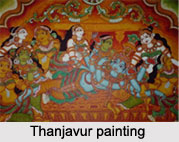 Paintings in South India are famous for their intricate curves and bright colours. There are many schools for painting in South India like the Mysore, Tanjore, Nayaka, Chola and so on. Pallava period paintings are known to us from small fragments recorded in the little shrines to set into the area wall of the Kailashnath temple at Kanchipuram. Mural and album paintings from the last 2 or 3 centuries stay alive in some extent from the South Indian paintings; Hindu paintings from the more isolated past survived to much lesser degree.
Paintings in South India are famous for their intricate curves and bright colours. There are many schools for painting in South India like the Mysore, Tanjore, Nayaka, Chola and so on. Pallava period paintings are known to us from small fragments recorded in the little shrines to set into the area wall of the Kailashnath temple at Kanchipuram. Mural and album paintings from the last 2 or 3 centuries stay alive in some extent from the South Indian paintings; Hindu paintings from the more isolated past survived to much lesser degree.
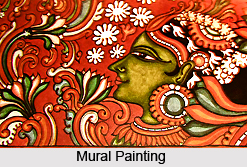 Paintings are the one of the most appropriate ways for the expressions of human imaginations and thoughts since time immemorial. This form of art has been an integral part of the culture and tradition of India. Historical records have furnished numerous evidences of beautiful paintings dating back to the age of early civilization. Various caves and religious places hold the testaments of varied painting forms. Paintings of India have been hugely influenced by the different cultures prevailing in different regions of the country. However, in course of time, many regions have developed their unique style of painting which later became the representatives of their cultural heritage. Paintings of Southern India, over time, have also developed as hugely acclaimed forms of art in India.
Paintings are the one of the most appropriate ways for the expressions of human imaginations and thoughts since time immemorial. This form of art has been an integral part of the culture and tradition of India. Historical records have furnished numerous evidences of beautiful paintings dating back to the age of early civilization. Various caves and religious places hold the testaments of varied painting forms. Paintings of India have been hugely influenced by the different cultures prevailing in different regions of the country. However, in course of time, many regions have developed their unique style of painting which later became the representatives of their cultural heritage. Paintings of Southern India, over time, have also developed as hugely acclaimed forms of art in India.
History of South Indian Paintings
The art form dates back to the early 9th century which was an era dominated by the Chola rulers, who encouraged art and literature. Tanjore painting is an imperative form of classical South Indian painting was the subject to the town of Tanjore in Tamil Nadu. The Miniature Painting in India expressed realism with its complete subtleties. The diverse schools of Indian miniatures like the Pala, Odisha, Jain, Mughal, Rajasthani and Nepali did not cultivate after separation. The 11th century Pala miniatures were the earliest to appear. The Tanjore Paintings dates back to the early 9th century which was an era dominated by the Chola rulers, who promoted art and literature.
Features of South Indian Paintings
The ideas consist of the story of Radha-Krishna, scenes from Ramayana and Mahabharata temple activities and others. A significant feature of chitrakars is they utilize vegetable and sandstone colours.
Types of South Indian Paintings
The tradition of South Indian painting has been carried on in the Indian subcontinent since the ancient times. With the time, South Indian paintings developed to turn into a kind of merge of the different traditions which were influencing them. There are different types of South Indian Paintings which are existing and some of them are as follows:
Thanjavur Painting: Thanjavur painting is a traditional South Indian painting style, which was inaugurated from the town of Thanjavur and spread across the adjoining and geographically nearby Tamil Nadu. The art form draws its instant resources and inspiration from way back about 1600 AD, an era when the Nayakas of Thanjavur under the suzerainty of the Vijayanagara Rayas encouraged art. However, it can safely be surmised that Thanjavur painting, as we know it now, originated in the Maratha court of Thanjavur.
Mysore Painting: Mysore painting is an important form of classical South Indian painting that originated in the town of Mysore in Karnataka. These paintings are known for their elegance, muted colours and attention to detail. The themes for most of these paintings are Hindu Gods and Goddesses and scenes from Hindu mythology. In modern times, these paintings have become a much sought-after souvenir during festive occasions in South India.
Karnataka Painting: The original paintings of Karnataka are of the pre-historic era about 2000 to1000 B.C. The depictions of animals, human figures etc. are painted under the projected rocks which formed the home place of the ancient people. The practice of paintings in Karnataka owes its beginnings to the western Chalukyans who embellished the walls of the caves in Badami with attractive wall paintings in 6th century A.D.
Hoysala Painting: Hoysala paintings of South India are available in the painted palm leaf manuscripts, which are now well preserved in the Moodhidri library. They are illustrated manuscripts and thus do not contain only paintings but also the writing of the Hoysala period. The mural tradition has been a very vital practice in South Indian painting and images are accurately cut into rocks of the caves.
Paintings of Kerala
Art is highly developed in the state of Kerala. One of the most acclaimed paintings of the state is the mural paintings of Kerala. These are mainly the frescos that depict legends and mythology. This exotic art can be witnessed in temples and churches of the state. This ancient form of art can be traced back to 9th century. The state has a rich and ancient tradition of mural paintings. In mural paintings beautiful imaginations find exquisite expressions in unique forms and vivid hues. The colours usually used in these paintings are herbal vegetable dyes, minerals, fruit juices and chemicals extracted from roots, earth, stones etc. Bamboo pieces are sharpened to draw the outlines and the brushes for painting are composed of blades made out of roots and certain type of grasses. Mural paintings exhibit elaborate scenes of religious as well as mystic themes. Brilliant manifestations of mural paintings can be seen in temples at Trikodithanam, Vaikom, Udayanapuram, Triprangode, Kumaranalloor etc.
Paintings of Karnataka
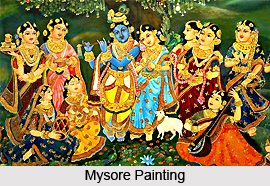 One of the most famous traditional paintings of Karnataka is Mysore painting. The history of Mysore painting can be traced back to 2nd century BC, Ajanta times. During the rule of the Vijayanagara Kings from 1336 to 1565 AD, the paintings gained further prominence. These paintings are characterized by their detailed depiction, muted colours and elegance. In Mysore paintings, colours used were extracted from natural sources like vegetables, flowers, leaves and minerals. Vibrant colours, delicate brush strokes and beautiful delineation of figures are the most prominent features of Mysore paintings. Mural paintings are also popular in the state of Karnataka. Several evidences support the fact that these paintings form an inseparable part of the tradition and cultural heritage of Karnataka since ancient times. Ancient caves like Caves of Badamai have been found to house magnificent samples of mural painting that consolidates the fact that this form of art had existed in India since 7th century AD. Beautiful narrations adorn these caves depicting scenes from day to day life of common people. Mural paintings of Karnataka gained further popularity during Vijayanagar Empire, Chalukyan period and Mysore dynasties. The paintings in each of these phases however conferred unique characteristic features.
One of the most famous traditional paintings of Karnataka is Mysore painting. The history of Mysore painting can be traced back to 2nd century BC, Ajanta times. During the rule of the Vijayanagara Kings from 1336 to 1565 AD, the paintings gained further prominence. These paintings are characterized by their detailed depiction, muted colours and elegance. In Mysore paintings, colours used were extracted from natural sources like vegetables, flowers, leaves and minerals. Vibrant colours, delicate brush strokes and beautiful delineation of figures are the most prominent features of Mysore paintings. Mural paintings are also popular in the state of Karnataka. Several evidences support the fact that these paintings form an inseparable part of the tradition and cultural heritage of Karnataka since ancient times. Ancient caves like Caves of Badamai have been found to house magnificent samples of mural painting that consolidates the fact that this form of art had existed in India since 7th century AD. Beautiful narrations adorn these caves depicting scenes from day to day life of common people. Mural paintings of Karnataka gained further popularity during Vijayanagar Empire, Chalukyan period and Mysore dynasties. The paintings in each of these phases however conferred unique characteristic features.
Paintings of Tamil Nadu
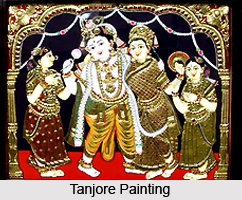 Tanjore painting is a highly renowned form of painting which is centred mainly in the town of Thanjavur, in Tamil Nadu. It is an ancient painting having its origin enrooted in 1600 AD when Thanjavur Nayakas greatly encouraged different forms of art. The most alluring features of Tanjore paintings are vibrant hues, surface richness and compact composition. Gold foils are used in these paintings to provide a rich look to the paintings. Most common depictions in this art are the saints, Hindu Gods and Goddess. These are basically done on wooden planks in the form of panels. Modern forms of Tanjore paintings have become famous as souvenirs for South Indian festivals and occasions. Apart from this, mural paintings are also prevalent in the state of Tamil Nadu since long. Portrayal of mythological tales through mural paintings forms the adornment of several temples in Tamil Nadu.
Tanjore painting is a highly renowned form of painting which is centred mainly in the town of Thanjavur, in Tamil Nadu. It is an ancient painting having its origin enrooted in 1600 AD when Thanjavur Nayakas greatly encouraged different forms of art. The most alluring features of Tanjore paintings are vibrant hues, surface richness and compact composition. Gold foils are used in these paintings to provide a rich look to the paintings. Most common depictions in this art are the saints, Hindu Gods and Goddess. These are basically done on wooden planks in the form of panels. Modern forms of Tanjore paintings have become famous as souvenirs for South Indian festivals and occasions. Apart from this, mural paintings are also prevalent in the state of Tamil Nadu since long. Portrayal of mythological tales through mural paintings forms the adornment of several temples in Tamil Nadu.
Indian painting previously hovered mostly around religious beliefs but later owing to the influences of a number of cultures and traditions they evolved as the most versatile form of expressions. A number of enchanting paintings emerged in south India, which have gained acclamations all over the country. Mural Paintings are the most common paintings prevalent almost in all the regions of south India. Paintings of Southern India greatly enrich the cultural heritage of the country.
Paintings of Prehistoric Man in South India
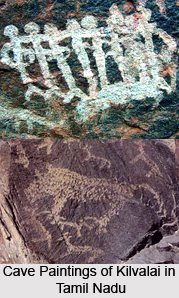 Art has no particular history of its origin. Since the prehistoric days, man had been painting in stones and rocks. Earlier, man was entirely dependent on stones and so they used to settle down in places where the stones can be found nearby. Thus, the beautiful paintings of that period can be found only in those stones and engravings on rocks and caves.
Art has no particular history of its origin. Since the prehistoric days, man had been painting in stones and rocks. Earlier, man was entirely dependent on stones and so they used to settle down in places where the stones can be found nearby. Thus, the beautiful paintings of that period can be found only in those stones and engravings on rocks and caves.
These prehistoric paintings found in the rocks reveal the engravings of animals, birds, human figures, hunting scenes and geometric designs. The Bhimbhetka in Madhya Pradesh is well known for its prehistoric rock art. The Benekal forest, Maski and Koppgallu in Karnataka and Porivarai (near Karikaiyur) and Kilvalai in Tamil Nadu are the places of South India where prehistoric rock art can be seen. Porivarai situated in the Nilgiris hills of Tamil Nadu district is popular among all the prehistoric rock art found in South India. Porivarai is placed in a deep jungle crowded with wildlife. One of the largest prehistoric paintings of South Asia is the rock painting found here in Porivarai. The theme of the painting consists of hunting scenes and dancing scenes.
These prehistoric arts of South India later influenced the art of later periods. For example, the human figures seen on the rocks at Benekal forest, Maski, Koppgallu in Karnataka and Porivarai in Tamil Nadu and a few other sites are have a remarkable similarity with human figures on the karshapanas or punch-marked coins that were used as money in India approximately from 600 B.C. to 100 A.D.
Most of these rock-art samples and coins have shown the human body in the `S` twists form. These also represent dynamism of action. The archaic Ujjain symbol seen at Porivarai represents a four-armed symbol. It has some similarity with the same type of symbol seen on the `Karsbapanas`. The same happens with the animal paintings in Porivarai. These animals are mostly shown in profile as on many of the karsbapanas.
Again, some of the bulls embodied on the rocks at Koppgallu have stylistic resemblance with the bulls on the karsbapanas.
Many other art-motifs and symbols comprising the `Nandipada` and various geometric designs are common to both, the rock-art, mainly paintings found at sites like Kilvalai in Tamil Nadu, and the punch-marked coins. The prehistoric paintings and rock arts are now situated mostly in remote areas, deep into the forest. Therefore, these sites are not known by the common people and they do not attract the tourists also for the same reason.
Paintings of Nayaka Period
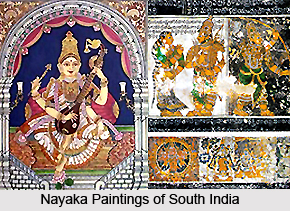 The paintings of the Nayak phase of Madurai and Tanjavur was as important as the Vijayanagara phase. The traces of Nayaka paintings can be seen at the Tiruparuthikundram apart from the Vijayanagara paintings. Most of these paintings of Nayaka period are of the 16th century and few are from the 17th century.
The paintings of the Nayak phase of Madurai and Tanjavur was as important as the Vijayanagara phase. The traces of Nayaka paintings can be seen at the Tiruparuthikundram apart from the Vijayanagara paintings. Most of these paintings of Nayaka period are of the 16th century and few are from the 17th century.
Depiction in Nayaka Paintings
These Nayaka paintings depict the scenes from the life of Rishabhadeva, the first Thirthankara of Vardhamana, of Krishna, the cousin of the Thirthankara, Neminatha as well as the life of Neminatha himself. These are all graphically portrayed in a long series with elaborate labels in Tamil language giving details of each painting which became the usual feature as such labels are seen in Chidambaram paintings and Tiruvalur etc.
Nayaka Paintings in Tanjavur
In the Tanjavur temple, there is a long panel facing west, in the circumambulatory passage. This shows Lord Indra on an elephant, Agni (the Lord of Fire) on a ram, Yama (God of Death) on a buffalo, Niritti on a human mount, Varuna (Rain God) on a makara and Marut (Wind God) on a deer. These Nayaka paintings depict the glory of Indra by repeating him on an elephant at one end. These paintings depict the `samudra manthana` scene, showing the rising of the objects from the ocean as it was churned. The things rose shown here include the Kalpavriksha (wish-fulfilling tree), Uchchaisravas (celestial horse), Airavata (heavenly elephant), Kamadhenu (the cow of plenty), Rambha, Urvasi (celestial nymphs) and others. It also depicts Goddess Lakshmi is towards one end on a lotus, with her hands in a posture of assurance of protection and prosperity and is approached by the devatas. Many other such valuable and noteworthy Nayaka paintings can be seen in various temples of Kumbakonam and other places in Tanjavur district.
Nayaka Paintings in Tiruvarur
The Tiruvarur temple is among the most famous Saivite shrines of South India. One of such paintings of the late 17th and early 18th centuries can be seen on the ceiling, between the rows of pillars in the thousand pillared mandapa. In this painting, the great devotee of Siva, Muchukunda Chola is portrayed as a great friend of Indra and as his great ally in overcoming the asuras. He is shown majestically riding on an elephant in a procession. He is received with great honor by Indra at the entrance of the city and beautiful celestial damsels are shown honoring him from their balconies, which is most beautifully represented.
Nayaka Paintings in Chidambaram
On the ceiling of the large mandapa of Chidambaram temple, there is a nice Nayaka painting depicting the story of the genesis of the Bikshatana form of Siva and Mohini form of Vishnu. The plan of Siva and Vishnu was to proceed to Darukavana to protect the rishis and rishipatnis (wives of the rishis) by assuming the guise of the naked beggar and the bewitching enchantress. In one of the paintings Ganesa (the elephant faced god) and Umasahita are shown with rishis, Skanda (Muruga) with Valli and Devasena. This painting can be seen towards the other end of the mandapa. Here, one can also see Nandi conversing with Siva and Parvati in Kailasa, Nataraja as Sabhapati with Sivakamasundari (Parvati) surrounded by Ganas dancing and playing musical instruments. These Nayaka paintings here also depict several other stories from Sivapurana, illustrating the lives of saints.
Other Paintings of Nayaka Period
The temple of Tiruvalanjuli has vigorously painted panels depicting Vishnuanugraha Murthi (blessing Vishnu). The story of Muruga teaching Pranava to Brahma and that of Siva with chinmudra is inscribed here. The paintings of the Nayaka period continue the traditions of the Vijayanagar craftsmen and they influenced the art of Mysore, Vellore, Penukonda and Srirangapattinam.
Chola Paintings of South India
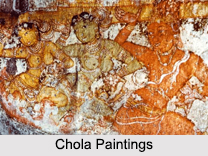 Chola Paintings of South Indian have very high significance in the history of art. These paintings have great emotion in the faces, whether it is anger, compassion or any other expression. The era of the royal Cholas was an era of continuous development and enhancement of Dravidian art and architecture. They utilised their extraordinary wealth which were earned during their widespread invasions in building long-lasting stone temples and beautiful bronze sculptures.
Chola Paintings of South Indian have very high significance in the history of art. These paintings have great emotion in the faces, whether it is anger, compassion or any other expression. The era of the royal Cholas was an era of continuous development and enhancement of Dravidian art and architecture. They utilised their extraordinary wealth which were earned during their widespread invasions in building long-lasting stone temples and beautiful bronze sculptures.
Features of Chola Paintings of South India
The murals of the Chola age bring out diverse emotions on many faces, a feature rarely seen in Indian art. The majestic temple of Brihadishvara in Thanjavur is an example of the great wealth and power of the Chola Empire. The art of paintings boomed, Figures were painted with realism. The ability of the Chola painters is seen on their paintings. Most the paintings are massive and animated, which brings alive the greatness of the Lord who destroys evil and ensures peace. These paintings also depict a barely visible Dakshinamurthi (Shiva as God of knowledge) beneath a banyan tree on which monkeys are playing. The paintings of the Chola period have a stillness of body and astonishment on the faces of the sages worshipping Dakshinamurthi, in contrast to the energetic animals portrayed nearby. There are also flying apsaras and gandharas, who complete the scene of extravagant proportions. The paintings of Lord Shiva can be seen in the heart of the temple, which are protected by gigantic walls of stone. Here, a forceful Shiva is shown as warrior on a chariot, which is being driven by Brahma and fighting the demons who can be clearly recognised by their fearful appearance.
There is another Chola painting of South India, which shows a beautiful tableau of Rajaraja Chola I listening to his preceptor Karuvur Devar and the two are facing a study of intense concentration. This is said to be one of the earliest royal portraits in Indian painting. In another panel, there are dancing apsaras and their faces are in the pose of abhinaya. Again, in the paintings are shown Rajaraja Chola and his wives watching in awe the magnificent ananda tandava, the dance of Nataraja performed in the golden mandapam of Chidambaram. There are also people with eyebrows like a bow and the compassionate eyes, who are shown wearing beautiful jewellery and jasmine bedecked hairstyles. These beautifully featured people bring alive the massive compositions in bright colours. Most of the Chola paintings were rediscovered when the upper layer was removed to be preserved separately. Rajaraja-I and Rajendra contributed most for the growth of the art of painting throughout the Chola period. The big Chola king Raja Raja I built the Brihadisvara temple between AD 1000 and AD 1008 and the paintings were done between AD 1008 and AD 1012.



















